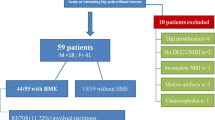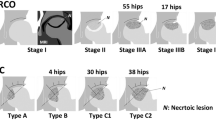Abstract
Objectives
To evaluate the diagnostic performance of dual-energy CT with water-hydroxyapatite (HAP) imaging for bone marrow edema in patients with non-traumatic hip pain.
Methods
Forty patients (mean age, 58 years; 16 male and 24 female) who underwent rapid kVp-switching dual-energy CT and MRI within 1 month between April 2018 and February 2019 with hip pain but no trauma were enrolled. Two radiologists retrospectively evaluated 80 hip joints for the presence, extent (femoral head involved, head and neck, and head to intertrochanter), and severity (mild edema, moderate, severe) of bone marrow edema on dual-energy water-HAP images. Water mass density (mg/cm3) on water-HAP images was determined with region of interest–based quantitative analysis. MRI served as the standard of reference.
Results
Sensitivity, specificity, and accuracy of readers 1 and 2 for the identification of bone marrow edema in water-HAP images were 85% and 85%, 93% and 73%, and 89% and 79%, respectively. The area under the receiver operating characteristic curve was 0.96 for reader 1 and 0.91 for reader 2 for differentiation of the presence of edema from no edema. The optimal water mass density to classify the presence of edema for reader 1 was 951 mg/cm3 with 93% sensitivity and 93% specificity and for reader 2 was 957 mg/cm3 with 80% sensitivity and 80% specificity. The more severe the edema, the higher was the mean water density value (p < 0.035).
Conclusion
Dual-energy water-HAP images showed good diagnostic performance for bone marrow edema in patients with non-traumatic hip pain.
Key Points
• Dual-energy water-HAP imaging depicts bone marrow edema in patients with non-traumatic hip pain and may serve as an alternative to MRI in select patients.
• A cutoff value of 951 mg/cm 3 mean water mass density results in 93% sensitivity and 93% specificity for the detection of bone marrow edema.
• The more severe the bone marrow edema, the higher the mean water density value.




Similar content being viewed by others
Abbreviations
- AUROC:
-
Area under the receiver operating characteristic
- CI:
-
Confidence interval
- CT:
-
Computed tomography
- CTDI:
-
Computed tomography dose index
- DECT:
-
Dual-energy computed tomography
- HAP:
-
Hydroxyapatite
- ICC:
-
Interclass correlation coefficient
- MR:
-
Magnetic resonance
- MRI:
-
Magnetic resonance imaging
- NPV:
-
Negative predictive value
- PPV:
-
Positive predictive value
- ROC:
-
Receiver operating characteristic
- ROI:
-
Region of interest
References
Link TM, Steinbach LS, Ghosh S et al (2003) Osteoarthritis: MR imaging findings in different stages of disease and correlation with clinical findings. Radiology 226:373–381
Murphey MD, Foreman KL, Klassen-Fischer MK, Fox MG, Chung EM, Kransdorf MJ (2014) From the radiologic pathology archives imaging of osteonecrosis: radiologic-pathologic correlation. Radiographics 34:1003–1028
Kijowski R, Stanton P, Fine J, De Smet A (2006) Subchondral bone marrow edema in patients with degeneration of the articular cartilage of the knee joint. Radiology 238:943–949
Taljanovic MS, Graham AR, Benjamin JB et al (2008) Bone marrow edema pattern in advanced hip osteoarthritis: quantitative assessment with magnetic resonance imaging and correlation with clinical examination, radiographic findings, and histopathology. Skeletal Radiol 37:423–431
Felson DT, McLaughlin S, Goggins J et al (2003) Bone marrow edema and its relation to progression of knee osteoarthritis. Ann Intern Med 139:330–336
Iida S, Harada Y, Shimizu K et al (2000) Correlation between bone marrow edema and collapse of the femoral head in steroid-induced osteonecrosis. AJR Am J Roentgenol 174:735–743
Ito H, Matsuno T, Minami A (2006) Relationship between bone marrow edema and development of symptoms in patients with osteonecrosis of the femoral head. AJR Am J Roentgenol 186:1761–1770
Ragab Y, Emad Y, Abou-Zeid A (2008) Bone marrow edema syndromes of the hip: MRI features in different hip disorders. Clin Rheumatol 27:475–482
Mallinson PI, Coupal TM, McLaughlin PD, Nicolaou S, Munk PL, Ouellette HA (2016) Dual-energy CT for the musculoskeletal system. Radiology 281:690–707
Booz C, Nöske J, Martin SS et al (2018) Virtual noncalcium dual-energy CT: detection of lumbar disk herniation in comparison with standard gray-scale CT. Radiology 290:446–455
Wu H, Zhang G, Shi L et al (2018) Axial spondyloarthritis: dual-energy virtual noncalcium CT in the detection of bone marrow edema in the sacroiliac joints. Radiology 290:157–164
Kellock TT, Nicolaou S, Kim SS et al (2017) Detection of bone marrow edema in nondisplaced hip fractures: utility of a virtual noncalcium dual-energy CT application. Radiology 284:798–805
Stevens K, Tao C, Lee S-U et al (2003) Subchondral fractures in osteonecrosis of the femoral head: comparison of radiography, CT, and MR imaging. AJR Am J Roentgenol 180:363–368
Wang CK, Tsai JM, Chuang MT,Wang MT, Huang KY, Lin RM (2013) Bone marrow edema in vertebral compression fractures: detection with dual-energy CT. Radiology 269:525–533
Kaup M, Wichmann JL, Scholtz JE et al (2016) Dual-energy CT–based display of bone marrow edema in osteoporotic vertebral compression fractures: impact on diagnostic accuracy of radiologists with varying levels of experience in correlation to MR imaging. Radiology 280:510–519
Pache G, Krauss B, Strohm P et al (2010) Dual-energy CT virtual noncalcium technique: detecting posttraumatic bone marrow lesions—feasibility study. Radiology 256:617–624
Patino M, Prochowski A, Agrawal MD et al (2016) Material separation using dual-energy CT: current and emerging applications. Radiographics 36:1087–1105
Mendonça PR, Lamb P, Sahani DV (2013) A flexible method for multi-material decomposition of dual-energy CT images. IEEE Trans Med Imaging 33:99–116
Guggenberger R, Gnannt R, Hodler J et al (2012) Diagnostic performance of dual-energy CT for the detection of traumatic bone marrow lesions in the ankle: comparison with MR imaging. Radiology 264:164–173
Reddy T, McLaughlin P, Mallinson P et al (2015) Detection of occult, undisplaced hip fractures with a dual-energy CT algorithm targeted to detection of bone marrow edema. Emerg Radiol 22:25–29
Kosmala A, Weng AM, Krauss B, Knop S, Bley TA, Petritsch B (2018) Dual-energy CT of the bone marrow in multiple myeloma: diagnostic accuracy for quantitative differentiation of infiltration patterns. Eur Radiol 28:5083–5090
Akisato K, Nishihara R, Okazaki H et al (2019) Dual-energy CT of material decomposition analysis for detection with bone marrow edema in patients with vertebral compression fractures. Acad Radiol
Kumar V, Abbas AK, Aster JC (2014) Robbins and Cotran pathologic basis of disease, 9th edn. Elsevier, Philadelphia
Gartner LP, Hiatt JL (2013) Color atlas and text of histology, 6th edn. Lippincott Williams & Wilkins, Baltimore Philadelphia
Ai S, Qu M, Glazebrook KN et al (2014) Use of dual-energy CT and virtual non-calcium techniques to evaluate post-traumatic bone bruises in knees in the subacute setting. Skeletal Radiol 43:1289–1295
International Commission on Radiation Units and Measurements (1992) Photon, electron, proton and neutron interaction data for body tissues (ICRU--46). Bethesda, MD
Hubbell JH, Seltzer SM (1995) Tables of X-ray mass attenuation coefficients and mass energy-absorption coefficients 1 keV to 20 MeV for elements Z = 1 to 92 and 48 additional substances of dosimetric interest. National Inst. of Standards and Technology - Ionizing Radiation Division. Gaithersburg, MD
Landis JR, Koch GG (1977) The measurement of observer agreement for categorical data. Biometrics 33:159–174
Diekhoff T, Hermann K, Pumberger M, Hamm B, Putzier M, Fuchs M (2017) Dual-energy CT virtual non-calcium technique for detection of bone marrow edema in patients with vertebral fractures: a prospective feasibility study on a single-source volume CT scanner. Eur J Radiol 87:59–65
Karachalios T, Karantanas AH, Malizos K (2007) Hip osteoarthritis: what the radiologist wants to know. Eur J Radiol 63:36–48
Koo K-H, Mont MA, Jones LC (2014) Osteonecrosis. Springer, Berlin Heidelberg
Malizos KN, Karantanas AH, Varitimidis SE, Dailiana ZH, Bargiotas K, Maris T (2007) Osteonecrosis of the femoral head: etiology, imaging and treatment. Eur J Radiol 63:16–28
Acknowledgments
The authors thank research scientist Yunsub Jung and CT application specialist Kyoung-A Um for their technical support and help in preparing the manuscript.
Funding
The authors state that this work has not received any funding.
Author information
Authors and Affiliations
Corresponding author
Ethics declarations
Guarantor
The scientific guarantor of this publication is Chankue Park.
Conflict of interest
The authors of this manuscript declare no relationships with any companies whose products or services may be related to the subject matter of the article.
Statistics and biometry
One of the authors (Chankue Park) has significant statistical expertise.
Informed consent
Written informed consent was waived by the Institutional Review Board.
Ethical approval
Institutional Review Board approval was obtained.
Methodology
• Retrospective
• Observational
• Performed at one institution
Additional information
Publisher’s note
Springer Nature remains neutral with regard to jurisdictional claims in published maps and institutional affiliations.
Rights and permissions
About this article
Cite this article
Son, W., Park, C., Jeong, H.S. et al. Bone marrow edema in non-traumatic hip: high accuracy of dual-energy CT with water-hydroxyapatite decomposition imaging. Eur Radiol 30, 2191–2198 (2020). https://doi.org/10.1007/s00330-019-06519-8
Received:
Revised:
Accepted:
Published:
Issue Date:
DOI: https://doi.org/10.1007/s00330-019-06519-8




